COVID-19 pandemic has adversely impacted Indian farmers rearing livestock and poultry. In this blog, Dr Mahesh Chander, M S Kannadhasan and Raj Kumar Patel discuss these new challenges, the interventions being made to address them and more that can be done to support farmers during and after the crisis.
CONTEXT
Lockdown has caused disruptions in livestock and poultry value chains in India, leading to a fall in procurement and sale of animal sourced food. Animals are suffering due to lack of adequate feed and veterinary care. Farmers’ problems are further aggravated by rumours and fake news linking animal products and COVID-19. All these are adversely affecting farmers’ income and economy at the state/national level (Box 1). Besides farmers, pet lovers are also in need of advice for saving their animals.
| Box 1. Hardship reports on livestock and poultry farming
Livestock industry and value chain
Poultry sector
Problems faced by pets and butcheries Problems due to rumours |
Due to movement restrictions imposed during lockdown, farmers are unable to collect feed and fodder for their animals. Restricted inter- and intra-state movement of supplies adversely affected feed manufacturing and distribution. Police officers in most places are stopping farmers from taking their animals to veterinary institutions. Transporting and selling animal products is yet another problem. Though veterinary hospitals and dispensaries are exempted during lockdown, veterinarians and the field staff of Animal Husbandry departments are finding it difficult to reach their workplaces due to lack of public transport and restrictions on use of personal vehicles.
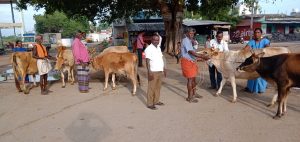
Besides these, both farmers and consumers of Animal sourced food (ASF) are fearful and insecure about animals and use of ASF during this period. They often ask:
- Do animals have any role in COVID-19 pandemic?
- How to protect animals, including companion animals, from humans infected or suspected to be infected with COVID-19?
- Is it safe to eat animal sourced food during COVID-19 pandemic?
- What are the precautions to be taken with animals and animal products?
These questions need to be answered for safeguarding animal and human welfare. Early action is needed to invalidate fake news and educate people to take precautions. Livestock and poultry farmers need information about several such aspects during lockdown (Box 2).
Box 2.Farmers’ needs on knowledge and skills/practices during lockdown
|
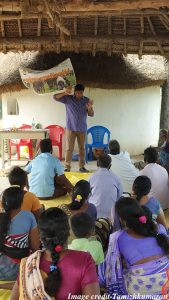 Livestock extension and advisory services (EAS) are expected to support farmers to overcome these challenges during this difficult period. How successful has EAS been in promoting production and health care practices, alongside provision of marketing information? This blog will attempt to answer.
Livestock extension and advisory services (EAS) are expected to support farmers to overcome these challenges during this difficult period. How successful has EAS been in promoting production and health care practices, alongside provision of marketing information? This blog will attempt to answer.
EXTENSION INTERVENTION AND INITIATIVES DURING LOCKDOWN
Initiatives by Government of India
The Government of India exempted veterinary services from lockdown restrictions. Addendum to guidelines, annexed to the Ministry of Home Affairs’ Order No 40-3/2020-DM-I (A) dated 24 March, released 25 March, 2020, permitted veterinary hospitals under Clause 3 and directed authorities to implement.
The Government of India, Ministry of Home affairs, issued consolidated revised guidelines on the measures to be taken during lockdown 2.0 across the country except in containment zones from 20 April to 3 May, 2020, vide its order No. 40-3/2020-DM-I(A) dated 15 April, 2020. This makes several animal husbandry activities permissible (Box 3).
| Box 3. Lockdown 2.0 guidelines for animal husbandry activities from 20 April, 2020
Under 5. All health services (including AYUSH) to remain functional, such as:
Under 6. Agricultural and related activities and (D). Animal husbandry
Under 13. Supply of essential goods is allowed, as under:
Under 17. Movement of persons is allowed
|
In many places, livestock farmers are not yet aware of the exemptions and activities permitted during lockdown.
State level initiatives
Comparison of state level notes on advisories to farmers on livestock and poultry farming is presented below:
Table 1. A comparison of advisories to farmers during lockdown
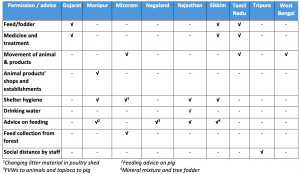
Though it is a nation-wide lockdown, inter-state variations aggravate problems and constraints on farmers. Some state governments have taken specific measures to support livestock and poultry farming (Box 4).
Guidelines shared by National Dairy Development Board (NDDB)
NDDB has disseminated essential advisory material to dairy federations across the country. It has developed and shared guidance documents including Measures to contain the spread of the COVID-19 virus, Guidelines for prevention of COVID-19 and Ethno-veterinary medicine (EVM). It issued an advisory and directed dairy cooperatives to make suitable arrangements for ensuring uninterrupted functioning and fodder availability in villages.
Advisories from ICAR – Indian Veterinary Research Institute (IVRI)
ICAR-IVRI has released advisory for livestock owners during COVID-19 Lockdown in English and Hindi in public interest. These advisories are on do’s and don’ts, homestead health care, preventive and protective measures to be taken across the value chain and by consumers, value addition and FAQs, myths and facts about COVID-19 etc.
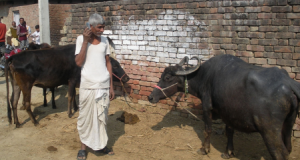
Krishi Vigyan Kendras (KVKs)
KVKs are issuing location specific advisories on crop, livestock, fisheries and related matters using information and communication technologies (ICTs). Also, they are sharing information on markets, availability of critical inputs, maintaining social distance, facilitating the installation of Aarogya Setu app, immunity enhancing protocol, etc. Also, a few KVKs are engaged in specific activities to respond to COVID-19 (Table 2). However, KVKs may not have subject matter specialists in Animal Sciences, Extension and Fisheries, which can restrict their advisories to crops.
Table 2. KVK interventions amid COVID-19 lockdown
| SNo. | Institute | Extension intervention |
| 1 | KVK, Ernakulam, under ICAR-Central Marine Fisheries Research Institute (CMFRI) | Door delivery facility for the fish lovers of Kochi |
| 2 | The Sahbhagita, a self-help group formed by the ICAR-Central Institute for Subtropical Horticulture(CISH), Lucknow, Uttar Pradesh (Box 5) | Promotes egg and chicken production in the mango belt of Malihabad
|
| 3 | ICAR-Indian Veterinary Research Institute including KVK of ICAR-IVRI, Izatnagar, Uttar Pradesh | Timely information to livestock farmers via WhatsApp, YouTube, Facebook, mobile apps, KVK portal, All India Radio including presentation via Zoom |
| Box 5. Shri Mohammad Shafiq’s experience
Sharing his experience of poultry production, Shri Mohammad Shafiq stated that during the lockdown he is earning Rs 300 per tray or Rs 30 per egg in the case of eggs from Kadaknath breed. Trained farmers and Senior Research Fellow (SRF) of CISH, Lucknow, who are posted in the village proved to be very helpful in educating farmers about social distancing and hygiene. |
The scope of social media in offering EAS is tremendous during COVID-19 lockdown. Social media such as WhatsApp, Telegram, Facebook and YouTube are successfully used by extensionists to offer EAS. Also, social media can be used to disseminate truthful and factual information to counter fake news (Box 6). While disseminating information including input dealers is beneficial.
Strength and limitations of livestock extension system in India
Box 7. Strength of livestock extension system in India
|
Box 8. Limitations of livestock extension system in India
|
This in turn reflects in poor performance at the field levels. Despite the large number of livestock in India, livestock extension remains grossly neglected. The outnumbering of strengths (Box 7) by limitations (Box 8) reflects poor EAS at field level. Hence, mission mode approach is needed to deliver EAS amid COVID-19 lockdown.
WHAT MORE NEEDS TO BE DONE?
Various stakeholders in the livestock and poultry sector need to stay connected through social media, follow etiquette and collaborate their efforts in EAS by playing their roles as mentioned in Table 3.
Table 3.Role of varied stakeholders
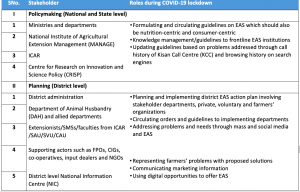
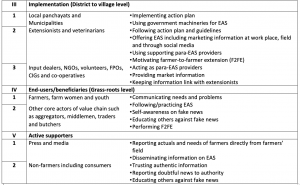
There is no real livestock extension in the country as the emphasis has been mostly on treatment and vaccination. The roles of stakeholders mentioned in Table 3 are, predominantly, irrespective of lockdown. However, these would be useful for future interventions.
Specific roles for Livestock EAS
Enhancing EAS delivery through online and social media
- Webpages of official websites of EAS offering institutes, containing advisory information on animal keeping and management during lockdown, should be made directly accessible without sign up at free of cost
- Options for online feedback
- Periodical short brief on extension talks should be circulated in social media.
Potential of FPOs and cooperatives
The potential of FPOs and cooperatives needs to be effectively utilized by EAS to help farmers sell their products and share information and updates on farming. But FPOs, despite efforts made, are not in good numbers, particularly in livestock and poultry sector. Cooperatives carryout EAS as one of their mandates. Similarly, cooperatives in livestock and poultry sector, except dairy cooperatives, are also few in number.
Strategies for using traditional mass media
- Information broadcast on radio and television to harness the flexibility and ubiquity of mass-media technologies effectively
- Volunteerism by newspapers in allotting exclusive page or column for information on livestock and poultry farming written by SMSs/extensionists/faculties of EAS offering institutes is desirable
- Community radio is a good means to connect with farmers because of their strengths in local dialects, local issues and solutions with community participation. But, only a few institutions are effectively running these.
EAS to pet animal owners
The fear of COVID-19 has been reflected by pet lovers too. Extensionists should alleviate their fear and depression by giving advisory services and counselling as per ‘One health’ concept that explains human health and animal health are interdependent and bound to the health of the ecosystems in which they exist.
LESSONS FOR THE FUTURE
Extensionists’ competency development: Extensionists need to be trained on next generation extension tools and New Extensionist Learning Kit (NELK) for providing EAS during crisis. The Module 13: Risk Mitigation and Adaptation in Extension could be particularly useful to handle crisis situation.
Alternative Feed Resources (AFR) origin: Extensionists should disseminate information on level of feeds of AFR origin such as commonly available fruits and vegetable wastes (FVWs). EAS providers in livestock sector can become acquainted with the utility of various FVWs to guide farmers in making good use in animal feeding. Policymakers need to consider AFR while formulating livestock and poultry extension policies and programmes.
Need for technology: Problems which need new technology to confront crisis have to be addressed and communicated as feedback to researchers. Such feedback in general is often missing.
Inclusive social network: Developing a social network involving all the stakeholders of EAS for timely information dissemination to all agricultural subsectors.
Farmer Producer Organization (FPO): Livestock and poultry farmers have to be supported to form FPOs by Small Farmers’ Agribusiness Consortium (SFAC) and National Bank for Agriculture and Rural Development (NABARD). FPOs need to be trained to play their role in EAS.
Marketing intelligence: Training in marketing intelligence needs to be imparted to face new customers and new markets.
Farm tours: Animal products from commercial farms are susceptible to fake news. To overcome this, commercial farmers should organize farm tours showing their farm hygiene.
Awareness exercise: Awareness through social media on related law and regulations for all the stakeholders of EAS needs to be conducted with more emphasis on farmers.
Data mining perspective for social media: To curb rumours, data mining perspective needs to be inculcated.
Extension and education never end: Stakeholder meetings need to be conducted to document their experience and feedback. The reason, factors and resources responsible for EAS delivery need to be discussed for better EAS during future crisis.
We know ASF is crucial for healthy human life. In India, difficulties faced by farmers in availing timely EAS is more severe during COVID-19 lockdown. Therefore, it is important to collaborate and coordinate with stakeholders to disseminate timely EAS to farmers and consumers.
 Dr Mahesh Chander is Principal Scientist & Head, Division of Extension Education at ICAR- Indian Veterinary Research Institute, Izatnagar-243 122, UP, India. (Email: drmahesh.chander@gmail.com)
Dr Mahesh Chander is Principal Scientist & Head, Division of Extension Education at ICAR- Indian Veterinary Research Institute, Izatnagar-243 122, UP, India. (Email: drmahesh.chander@gmail.com)
 M S Kannadhasan, Assistant Professor, VUTRC (TANUVAS), Dharmapuri-636701, Tamil Nadu, is currently pursuing PhD in Veterinary Extension Education at Division of Extension Education, ICAR- Indian Veterinary Research Institute, Izatnagar-243 122, UP, India. (Email: vetmskdhasan@gmail.com)
M S Kannadhasan, Assistant Professor, VUTRC (TANUVAS), Dharmapuri-636701, Tamil Nadu, is currently pursuing PhD in Veterinary Extension Education at Division of Extension Education, ICAR- Indian Veterinary Research Institute, Izatnagar-243 122, UP, India. (Email: vetmskdhasan@gmail.com)
 Raj Kumar Patel, Veterinary Assistant Surgeon, Madhya Pradesh State Department of Animal Husbandry, is currently pursuing PhD in Veterinary Extension Education at Division of Extension Education, ICAR- Indian Veterinary Research Institute, Izatnagar-243 122, UP, India. (Email: patel.drraj2019@gmail.com)
Raj Kumar Patel, Veterinary Assistant Surgeon, Madhya Pradesh State Department of Animal Husbandry, is currently pursuing PhD in Veterinary Extension Education at Division of Extension Education, ICAR- Indian Veterinary Research Institute, Izatnagar-243 122, UP, India. (Email: patel.drraj2019@gmail.com)

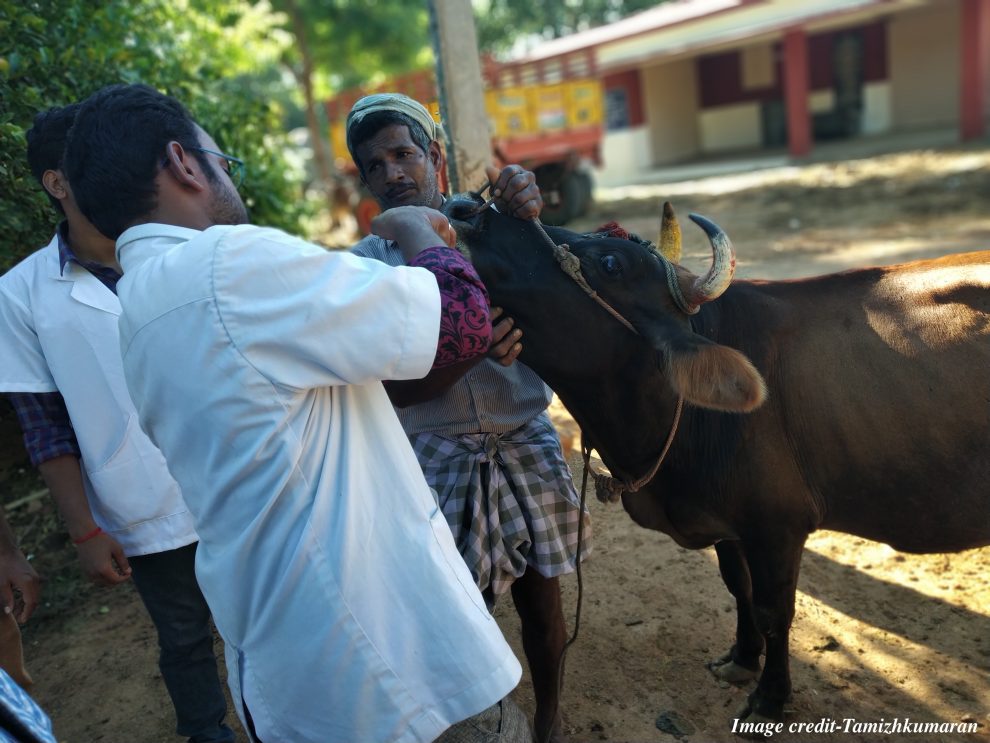
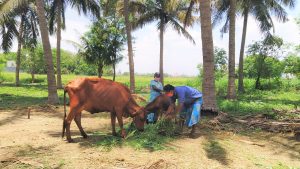

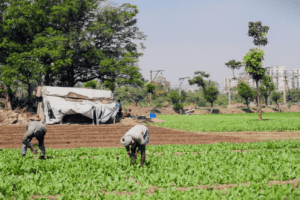

Thanks to Dr.Mahesh Chander and others for projecting the difficulties being faced by livestock
farmers and fishers. I am supplementing the following:
1. In dairy sector the milk producers are not able to sell the milk especially to private dairies.
The cooperative dairies must come to the rescue of the dairy farmers in collecting the extra
milk and thereby win the confidence of the milk producers as is happening in Karnataka,
Gujarat, Andhra Pradesh, Maharshtra etc. For instance the KMF is collecting extra milk than
they can sell or convert into SMP knowing pretty well it is incurring loss. But the Govt. of
Karnataka is helping it by procuring milk for free distribution to poor people. The
cooperative dairies in Odisha, Jharkhand, West Bengal etc also collect the milk instead of
forcing the dairy farmers to throw the milk. They should take this as an opportunity to win
the confidence of the dairy farmers. Instead of throwing milk it is better for the producers to
give to poor people or convert it into products like ghee which has long shelf life. EAS can
help in this direction.
2. With the interventions of the state and central Govts. the veterinary services are accessible
to the livestock owners. Only in some restricted areas, the farmers are not able to access
the services. Many institutions are sending advisories to the livestock owners through
various means. There is lot of scope to provide effective extension services to the livestock
owners by improving the quality and increasing the reach.
3. In poultry sector, both the integrators and farmers are facing the heat because of the
increase in feed cost. But it is expected that the poultry industry will recover soon. But the
small poultry or backyard poultry farmers are reaping the profits as the supply from the
neighbouring states is restricted.
4. The Govt.must enforce strict regulations in preventing the road side slaughter houses which
are posing serious threat in spreading the diseases including corona. EAS can play an
important role in educating both the slaughter house owners and consumers.
Though Livestock extension is neglected mostly, article delineates many steps taken by different agencies to provide extension and advisories to the farmers. Congratulations to authors for highlighting various initiatives from livestock extension during corona epidemic.
Extension science had evolved and implementation done by Western countries in late 19th and 20th century. Extension education in India got recognition after Independence. It’s extension education who made green revolution grand success and our country is self sustainable in quantity food grains. Now farmers are talking about quantity seeds, micronutrients, soil testing, balanced nutrient management, water harvesting etc. I mean that agricultural extension had evolved and got its place on the top due to its fraternity recognised importance of dissemination of knowledge of laboratory to land can only prove the importance of research station. Even various institutions started solely for extension services like KVK, ATMA and ATIC. These extension institutions act as bridge for research need and to and fro linkages. Agricultural extension had moved from production led extension to market led extension.
But the darker side of veterinary Extension is yet veterinary scientist had not recognised extension education and services as specialist job. Various top veterinary Universities like GADVSU Ludhiana had diluted it at grossroot level. They had made recruitment of surgery, medicine and gynaecology fellows in Extension descipline. Even after 73 years of independence, every veterinary University has not got extension specialist to teach their students, which had produced veterinary graduates for extension services but these are incompetent extensionist. These incompetent extensionist in veterinary sector had detoriated extension to extreme level.
In veterinary sector, there is only one grand sucess story of white revolution done by milk cooperative through market led extension. Rest all the technologies developed by any research institute had not got full exploration till date.
1. Artificial insemination was discovered as potent tool for upgradation of breed, still non descript animals are prevalent, proves it’s failure.
2. No institute had got its recognition for animal pool for purchasing good quality animal for starting a dairy venture.
3. Veterinary graduate cannot prepare feasible bank loan project
4. No veterinary graduate have interest in attracting farmer towards dairy or livestock enterprise.
5. In veterinary sector there is lack of livestock breeder, livestock nutristist, production manager, laboratory diagnosis, market advisor.
6. Only veterinary clinicians had got recognition and rest all are viped out, because veterinary fraternity and policy makers didnot recognised extension as potential tool for revolutionising the fraternity.
7. Even in more than 10 veterinary Universities, majority don’t have Directorate of Extension and if it is, it is led by some other fellow who don’t have basic knowledge of extension.
That’s why veterinary research institutes and veterinary College had not justified their research output and day by day government started derecognising and short cuting financial budget for veterinary research. Thanks to Dr Mahesh Chander sir and faculty of IVRI Bareilly, who had made existence of Extension in veterinary science, otherwise veterinary scientist had myth of
a) no need of extension in veterinary sector or
b) everyone can perform extension activities without basic knowledge of Extension science.
Impact of non existence of full fledge Veterinary Extension:
1. No technology had got its justified potential
2. No farmer leaves farming due to loss in agriculture, but dairy farmers had left livestock rearing resulting tremendous increase in stray animal population.
3. Non availability of timely veterinary extension advisory services
4. Veterinary Extensionist are not enough competent to give fruitful advices
5. Veterinary Extension limited to organising animal health camp, which is not job of extensionist but of clinician in the institute
6. Arrangements of physical facilities in the site of any program is done by Extension Scientist, which can be performed by any layman also.
7. Soon or later, veterinary research will be wiped out due to lack of its practical utility for the poor and pro poor farmers.
8. Veterinary Extension will be limited to capitalist of the country, who have capabilities to hire private veterinary Extension services, because number of competent veterinary Extensionist will be reduced to endangered level.
9. Milk and milk product adulteration had gone much deeper than one can expect. It might be my short sightedness, but I think no one can say I am procuring pure milk after paying double the market prices. Detoriation of milk constituent had been practiced leagally by milk cooperatives also in name of toned, double toned, standardized milk etc. Adulteration is due to huge gap in demand and supply, milk revolution is still awaited.
Very timely and well written covering diffrent aspects of livestock and poultry. Congratulations to the authors and AESA.